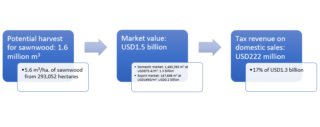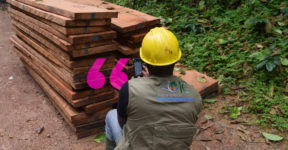
The Economics of Sustainable Forest Management in the Amazon
Over 770,000 hectares of forest was cleared in Brazil’s Amazon region in 2019 but over one third could have been sustainably managed for timber.
The Amazon rainforest is critical for maintaining planetary health, absorbing 5 per cent of all carbon dioxide generated by human activity, and playing an important role in supporting rural economies through the harvesting of timber and other products. Yet large swathes of the Amazon are being cleared every year, primarily for agricultural land, much of which takes place illegally.
Within Brazil’s Amazon region, legislation normally requires 80 per cent of private land to remain as forest and this can be used for harvesting timber and other forest products once a sustainable management plan is approved by a local environmental agency. However, this requirement is weakly enforced and the illegal clearance of forests has been widespread as a result of an economic model that assumes that agricultural expansion offers the best route to development.
But an alternative approach, based on the sustainable management of the rainforest for timber, could also generate significant economic benefits. An estimated USD1.5 billion of revenues from the sale of timber and USD220 million in sales taxes by state governments could have been generated in one year from land that was illegally deforested in 2019.
To estimate the potential revenues from timber harvesting, we considered those areas of forest that had been illegally deforested on land that could instead have been used for timber harvesting.
In 2019, 770,148 hectares of the Amazon rainforest was cleared and, of this area, just 2,122 hectares had been authorized for deforestation, while 474,974 hectares had been illegally cleared in protected territories, such as conservation areas and indigenous lands. This means that there were 293,052 hectares of illegally deforested land that could have been sustainably managed for products such as timber.
We estimated the volume and value of sawnwood – the main commercial timber product from Brazil’s tropical forests – that could have been sustainably harvested from this area of land based on existing data on current forest concessions with FSC-certification provided by local businesses and government agencies.
The data show that typical harvests are 16 m3 per hectare, of which 35 per cent (5.6 m3 per hectare) is transformed into sawnwood, with wood chips, firewood and residues making up the remainder. Therefore, from 293,052 hectares of forest, a of 1.6 million m3 of sawnwood could be expected.
The bulk of timber harvested in the Amazon – 91 per cent according to Imaflora – is sold within Brazil and average prices for sawnwood on the domestic market are reported to be USD875.4/m3, while for export, it is USD1650/m3. Applying these prices in these proportions to the potential harvest of 1.6 million m3, therefore, leads to an estimated sales value for sawnwood of over USD1.5 billion.
The generation of these revenues could, in turn, have generated tax income for state governments. The ICMS tax – a type of VAT – is applied at a rate of 17 per cent to domestic sales (12 per cent by the state of origin and 5 per cent by the destination state), and so, the USD1.3 billion in domestic sales of sawnwood would have resulted in tax revenues of over USD222 million.

Therefore, if the 293,000 hectares of forest that was illegally cleared in 2019 had been sustainably managed for timber, it would have generated over USD1.5 billion in business revenues, as well as USD222 million in taxes for state governments. What’s more, the forests would still be in place.
But these estimates are likely to be conservative for three reasons. Firstly, the area of degraded forests – the area of which is greater than deforested land – has not been considered. While the potential harvest from deforested land may have been over-estimated, since this land is likely to have included previously degraded forest, this would be on a far smaller scale.
Secondly, only sawnwood values were considered, but the sale of other products, such as fuelwood and woodchips, or the production of more value-added products, could have generated significant additional revenues.
Thirdly, potential state revenues from income tax, social security and business fees were not included in the calculation.
Brazil’s place in the world has changed over the last 10-15 years. It had previously been considered a rising star in the Global South and a trusted trading partner in the world. However, in recent years, it has become more isolated as international censure has grown over its response to the surging rates of deforestation and widespread forest fires in the Amazon.
France and Ireland, for example, have threatened to block approval of the Mercosur-EU trade deal because of concerns over the government’s handling of the Amazon forest fires while investors have been demanding action too and, more recently, incoming US President, Joe Biden, has called for Brazil to fight deforestation or face ‘economic consequences’.
Unless new approaches are adopted in Brazil, there is not only the risk that the Amazon rainforest will be lost, but so too will opportunities for economic development. With climate change and biodiversity loss both at the top of the international agenda, regulatory changes aimed at reducing the impact of investment and trade on forests are also on the horizon as both the US and Europe consider import controls for agricultural commodities linked with deforestation.
The time is ripe for Brazil to adopt a new approach. Measures to promote sustainable forests and livelihoods in the Amazon are supported by the majority of citizens in Brazil with 83 per cent indicating their concern about the loss of the Amazon.
Furthermore, multi-stakeholder platforms, such as the Brazilian Coalition on Climate, Forests and Agriculture, which are exploring alternative development models, have been gaining traction as well.
It is not possible to put a price tag on the Amazon rainforest not least because of its immense social, cultural and ecological value. However, ensuring that its full economic value is understood is crucial in helping decision-makers to determine how best to establish a truly resilient and sustainable economy for the region in the future.
The author would like to thank the following people: Alex Marega, SEMA MT; André Luiz Campos de Andrade, Ministério da Economia; Dalton Cardoso, Imazon; Fabio Bernardes, SEFA PA; Gustavo Bidiaga, IBAMA; Joaquim Levy, Safra Bank; Jose Humberto Chaves, Servico Florestal Brasileiro; Leonardo Martin Sobral and Marco Lentini, Imaflora; Secretario Mauro O' de Almeida, SEMAS PA; and Paula Bernasconi, ICV. All mistakes remain the authors’ own.


